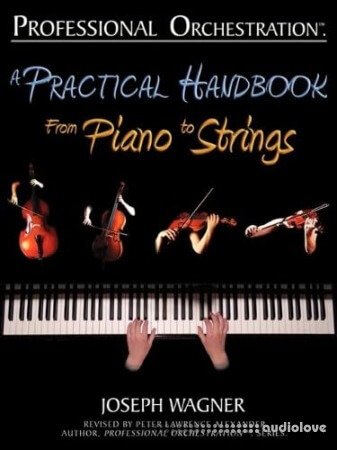Alexander Publishing A Practical Handbook: From Piano to Strings

This Bundle includes the PDF eBooks A Practical Handbook: From Piano To Strings, A Practical Handbook: Workbook and A Practical Handbook: MIDI/Audio Examples Package for a complete self-study solution.
The main Professional Orchestration.™ series of books contains the techniques you need to know to effectively score your music. By comparison, Professional Orchestration's A Practical Handbook series is applied orchestration where you apply the techniques with real pieces of music, scoring them first for strings, then woodwinds, then full orchestra.
You might find it helpful to go through Professional Orchestration Volumes 1 and 2A alongside the Handbook and Workbook, but they're not required. You can jump right in with From Piano to Strings, where you'll learn 13 broad techniques for turning piano parts into full scale string ensembles. The main book is supported by a Workbook, audio and MIDI files in this Bundle.
Background To The Handbook Series
Around 1922, Maurice Ravel finished his astonishing orchestration of Mussorgsky’s Pictures at An Exhibition. Sometime after that, someone talked the publisher of Ravel’s orchestration into adding the piano part at the bottom of the score so students could see how Ravel went from piano to orchestra.
In 1928, Arthur Edward Heacox, building on this simple idea, created the pocket-sized bok Project Lessons in Orchestration which taught orchestration by showing students how to go from piano to orchestra.
About 31 years later, in 1959, came Joseph Wagner, conductor, founder of the Civic Symphony Orchestra of Boston, and teacher of orchestration at Boston University. Dr. Wagner took Project Lessons in Orchestration to the next step by re-organizing Heacox’s material and creating the Reference Chart of Keyboard Idioms which organized piano techniques by comparable orchestral devices.
With this approach, Wagner put the piano part at the bottom of the score with his orchestration above it which, like Ravel’s score, enabled students to see how Wagner, using the same examples throughout the book, went from piano to strings, then piano to woodwinds, and finally, from piano to orchestra.
On the 50th Anniversary of Dr. Wagner’s magnum opus, this new edition of Professional Orchestration: A Practical Handbook - From Piano To Strings, was released as the first of three Handbooks, revised by Peter Lawrence Alexander. Also, the accompanying Workbook, and for the very first time - audio recordings of all the piano examples in the Workbook and the piano examples used in From Piano to Strings, (the same piano examples will be used in the forthcoming Handbooks From Piano to Woodwinds, and From Piano to Orchestra when those Handbooks are released).
About From Piano to Strings
From Piano to Strings is the first Handbook in the series. It teaches you 13 broad techniques from Joseph Wagner's Reference Chart of Keyboard Idioms for turning piano parts into full scale string ensembles. Each example contains the original piano part and the string ensemble orchestration above it, along with text explaining the background to the orchestration. Newly added text examines MIDI mockup issues. Newly created MIDI examples (included in this Bundle) contain both piano and string parts for you to import into your sequencing software. The piano examples have also been exported from Sibelius and recorded as MP3 audio for you to listen to as you study the Handbook.
Home page
DOWNLOAD
